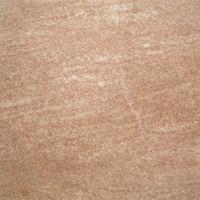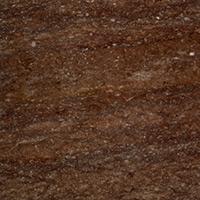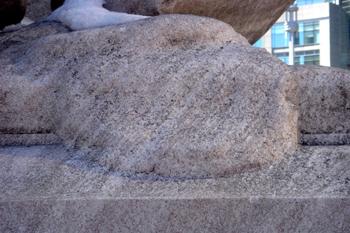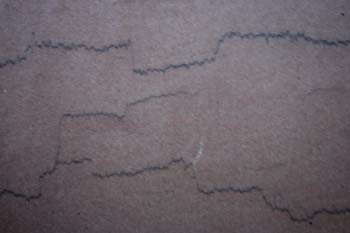
Floor of Grand Central Station
|
TENNESSEE
MARBLE
|
 |
|
| Official Name: | Holston Formation | |
| Location: | Knoxville area, Tennessee | |
| Age: | Middle Ordovican (460 MY) | |
| Lithology: | Limestone (Calcarenite/Grainstone/Biosparite) | |
| NYC Examples: | J.P.
Morgan Building, Floor of Grand Central Station |
|
|
Off-white, pink, and dark red limestone has been quarried from beds and lenses within the Holston Formation in the Valley and Ridge physiographic province of the Appalacians of eastern Tennessee since1838. The first operating Tennessee Marble quarry was near Rogersville, TN. Most other quarries are in the Knoxville area, including operational quarries near Friendsville, 35 km southwest of Knoxville. |
||
 Grey |
 Pink |
 Cedar |
|
In the minds of geologists, the rock commonly known as the Tennessee Marble is actually limestone, not marble at all. Why the confusion in classification? It is all about priorities... Geologists want to understand the Earth, its processes, and its history. Accordingly, geologists classify rocks based upon the processes by which they form: limestone is a sedimentary rock that forms by the the precipitation of calcite by chemical or biochemical processes, whereas a marble is a metamorphic rock that forms when a limestone is subjected to high pressure and/or temperature. In contrast, someone in the building stone industry would want to know how a rock will look and behave when incorporated into a building or monument. Accordingly, a quarrier or architect considers a marble to be any relatively soft rock that will take a polish. That includes the rocks that geologists classify as marble, along with compacted limestone, and even serpentinite. |
||
|
|
|
|
GEOLOGICAL FEATURES OF THE TENNESSEE MARBLE Features such as bedding, crossbedding, and well-preserved fossils are common in the Tennessee Marble, providing evidence for the sedimentary nature of this mis-named rock. |
|
 Bedding (Monument to the Maine, Central Park) |
 Crossbedding in Polished Stone Floor (Metropoltan Museum of Art, UES) |
|
Fragments of massive, hemispherical bryozoans are common in the Tennessee Marble. Bryozoans are tiny aquatic organisms (each of which is rarely larger than a millimeter) that live in colonies of interconnected individuals. Another distinct form of bryozoan within the Tennesee Marble is Archimedes, which consists of a corkscrew-like central axis around which more delicate, net-like colonies were attached. Because the the central axis is more robust, it is usually the only part of the skeletan preserved in the Tennesee Marble The bulbous form of the reef-building bryozoans of the Holson Formation was well-suited to the high-energy marine environments in which they lived; their form contrasts sharply with the delicate lacy fan-like, and branching bryozoans that are abundant in the Indiana Limestone, and which indicate a low-energy living environment. |
|
|
|
|
| Fragments of crinoid fossils (stems and disarticulated ossicles) are also abundant. Crinoids are a group of echinoderms that were abundant in the Paleozoic. These animals that are commonly referred to as "sea lilies". However, "feathery starfish on a stick" would be a better description. | |
|
|
|
|
Although certainly not a marble, the Tennessee Marble is far from pristine. Compressional stress that affected the region during the formation of the Appalachian Mountains caused the Tennessee Marbles to deform, and produce stylolites. These distinct deformation features are common in limestone and appear as dark, jagged lines on exposed surfaces. Stylolites form by dissolution of the limestone due to directed pressure. The dark material in a stylolite are insoluble residues. |
|
 Stylolite in Polished Stone Floor (Metropoltan Museum of Art, UES) |
 Stylolite in Weathered Stone Wall (JP Morgan and Company, Wall Street) |
|
A short Quicktime animation that illustrates the formation of a stylolite can be viewed at http://www.geo.lsa.umich.edu/~vdpluijm/animations/stylolite.mov |
|
|
ENVIRONMENT OF FORMATION The limestones of the Holston Formation formed during the Middle Ordovician (460 million years ago) in shallow water on the southern continental shelf of Laurentia. In this environment, bryozoan-dominated reefs flourished but the high energy of the waves often broke pieces of limestone from the reef. Such fragments of bryozoans rolled across the seafloor, together with fragmnents of other animals, and gradually built up porous shoals of coarse-grained limestone fragments. In the Late Ordovician, a volcanic island arc collided with the southern margin of Laurentia. Sedimentary rock srata from the continental margin, including the Holson Formation, were pushed landward, folded, broken, stacked and buried as the Taconic Mountains (Appalachians) rose. The pressure associated with the collision and burial compacted the limestone, and cemented the grains more firmly together, and produced distinct stylolites. Thus, collision-related deformation transformed the limestones of the Holston Formation into the dense, high-quality, polishabe stone known as the Tennessee marble. |
Image
adapted from: |
© 2005 Wayne G. Powell